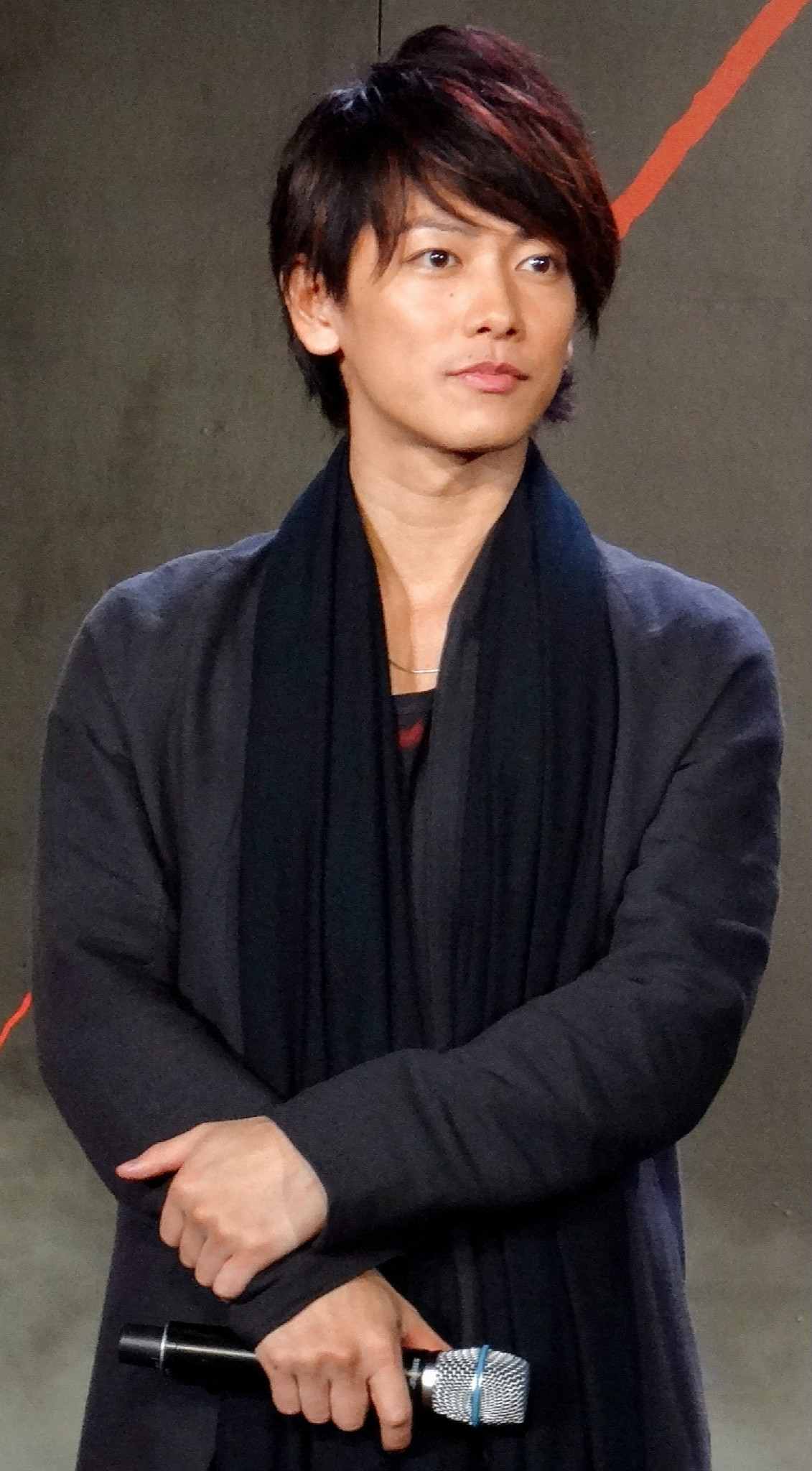|
Kirigakure Saizō
was a legendary ninja of the final phase of the Sengoku period of Japan. In the folklore he is one of the Sanada Ten Braves, and next to Sarutobi Sasuke, he is the most recognized of the Ten. As in the case of Sasuke, Saizō might be a fictional creation of the Meiji period, Meiji-period popular literature, possibly based on Kirigakure Shikaemon. His family name, meaning "Hide in the fog", is written with two kanji; kiri (霧) is the character for "fog", and gakure (隠) is the character for "hide". According to the historian Stephen Turnbull (historian), Stephen Turnbull and non-fiction writer Joel Levy, there is a historical record of a failed assassination attempt by a ninja called Kirigakure Saizō, sent by the warlord Tokugawa Ieyasu to kill his rival Toyotomi Hideyoshi (Tokichiro Kinoshita). According to another version of this incident, presented by the martial artist and researcher Donn F. Draeger, the "careless ninja" Saizō was captured while only spying on Hideyoshi, w ... [...More Info...] [...Related Items...] OR: [Wikipedia] [Google] [Baidu] |
Ninja
A or was a covert agent or mercenary in feudal Japan. The functions of a ninja included reconnaissance In military operations, reconnaissance or scouting is the exploration of an area by military forces to obtain information about enemy forces, terrain, and other activities. Examples of reconnaissance include patrolling by troops (skirmisher ..., espionage, Infiltration tactics, infiltration, Military deception, deception, ambush, bodyguarding and their fighting skills in martial arts, including ninjutsu.Kawakami, pp. 21–22 Their covert methods of waging irregular warfare were deemed dishonorable and beneath the honor of the samurai. Though ''shinobi'' proper, as specially trained spies and mercenaries, appeared in the 15th century during the Sengoku period, antecedents may have existed as early as the 12th century. In the unrest of the Sengoku period, mercenaries and spies for hire became active in Iga Province and the adjacent area around the village of Kōka, Shi ... [...More Info...] [...Related Items...] OR: [Wikipedia] [Google] [Baidu] |
Ishikawa Goemon
was a legendary Japanese outlaw hero who stole gold and other valuables to give to the poor. He and his son were boiled alive in public after their failed assassination attempt on the Sengoku period warlord Toyotomi Hideyoshi. His legend lives on in contemporary Japanese popular culture, often giving him greatly exaggerated ninja skills. Biography There is little historical information on Goemon's life, and as he has become a folk hero, his background and origins have been widely speculated upon. In his first appearance in the historical annals, in the 1642 biography of Hideyoshi, Goemon was referred to simply as a thief. As his legend became popular, various anti-authoritarian exploits were attributed to him, including a supposed assassination attempt against the Oda clan warlord Oda Nobunaga. There are many versions of Goemon's background and accounts of his life. According to one of them, he was born as Sanada Kuranoshin in 1558 to a samurai family in service of the power ... [...More Info...] [...Related Items...] OR: [Wikipedia] [Google] [Baidu] |
Ninja Sentai Kakuranger
is a Japanese ''tokusatsu'' television series. It was Toei Company Limited's eighteenth production of the Super Sentai metaseries. The name given to this series by Toei for international distribution is ''Ninja Rangers''. Action footage from the series was used in the third season of ''Mighty Morphin Power Rangers'' and ''Mighty Morphin Alien Rangers''. The core ''Zyuranger'' costumes from ''Kyōryū Sentai Zyuranger'' and the Kiba Ranger costume from ''Gosei Sentai Dairanger'' were mainly used in the third season of ''Mighty Morphin Power Rangers'' while the core ''Kakuranger'' costumes were used in ''Mighty Morphin Alien Rangers''. In January 2016, Shout! Factory announced that they would release "''Ninja Sentai Kakuranger'': The Complete Series" on DVD in North America. ''Kakuranger'' was released on DVD in North America on May 17, 2016. This is the third Super Sentai Series to be released in North America. In addition on May 22, 2017, Shout! streamed the series on their we ... [...More Info...] [...Related Items...] OR: [Wikipedia] [Google] [Baidu] |
Super Sentai
is a Japanese superhero team metaseries and media franchise consisting of television series and films produced by Toei Company, and Bandai, and aired by TV Asahi ("Sentai" is the Japanese word for "task force" or "fighting squadron"). The shows are of the ''tokusatsu'' genre, featuring live action characters and colorful special effects, and are aimed at children. ''Super Sentai'' airs alongside the '' Kamen Rider'' series in the ''Super Hero Time'' programming block on Sunday mornings. In North America, the ''Super Sentai'' series is best known as the source material for the ''Power Rangers'' series. Series overview In every ''Super Sentai'' series, the protagonists are a team of people who – using wrist-worn or hand-held devices – transform into superheroes and gain superpowers – color-coded uniforms, signature weapons, sidearms, and fighting skills – to battle a group of otherworldly supervillains that threaten to take over the Earth. In a typical episode, the her ... [...More Info...] [...Related Items...] OR: [Wikipedia] [Google] [Baidu] |
Onimusha Tactics
is a tactical role-playing video game developed and published by Capcom for the Game Boy Advance. A spin-off of the ''Onimusha'' series, it is the first and only game in the series to be released for a Nintendo system. It does not follow the storyline of the previous PlayStation 2 games and is considered a side story, but the game features a similar plot: a samurai who possesses the Oni Gauntlet can become the Onimusha and fights against Nobunaga and his army of genma. Gameplay The player is presented with a 3/4 camera view of a detailed gridded battlefield. The point of the game is to defeat the opposing team of opponents and improve the player character with experience points gained in battle by defeating enemies. Such statistics include strength, which dictates attack power, speed which decides turn order, and others. The game allows the player to equip their warrior with katanas, spears, and other weapons. Characters The samurai is Onimaru, who is supported by a wide ra ... [...More Info...] [...Related Items...] OR: [Wikipedia] [Google] [Baidu] |
Player Character
A player character (also known as a playable character or PC) is a fictional character in a video game or tabletop role-playing game whose actions are controlled by a player rather than the rules of the game. The characters that are not controlled by a player are called non-player characters (NPCs). The actions of non-player characters are typically handled by the game itself in video games, or according to rules followed by a gamemaster refereeing tabletop role-playing games. The player character functions as a fictional, alternate body for the player controlling the character. Video games typically have one player character for each person playing the game. Some games, such as multiplayer online battle arena, hero shooter, and fighting games, offer a group of player characters for the player to choose from, allowing the player to control one of them at a time. Where more than one player character is available, the characters may have distinctive abilities and differing styles ... [...More Info...] [...Related Items...] OR: [Wikipedia] [Google] [Baidu] |
Shinobi No Mono
is a series of jidaigeki novels written by Tomoyoshi Murayama originally serialized in the Sunday edition of the newspaper ''Akahata'' from November 1960 to May 1962. Shinobi no mono is the long form of the phrase meaning ninja, see the Ninja article for details. Novels Set during Japan's Sengoku period, the novels depicted Goemon Ishikawa, a famous outlaw hero who was boiled alive at the end of the 16th century by order of Hideyoshi Toyotomi, as a ninja who fought against samurai warlords. Films Between 1962 and 1966, a series of eight ''Shinobi no Mono'' films (aka ''Ninja, a Band of Assassins'', aka ''Ninja Spy'') starring Raizo Ichikawa were produced and released by the Daiei Motion Picture Company. The first three films are based on the novel, while the five subsequent films are based on four original screenplays by Hajime Takaiwa (also the screenwriter on the first three films) and one original screenplay by Kinya Naoi. * Following the death of series lead Raizo Ic ... [...More Info...] [...Related Items...] OR: [Wikipedia] [Google] [Baidu] |
I'm Born!
is the theatrical tokusatsu superhero film adaptation of the ''Kamen Rider Den-O'' TV series directed by Takao Nagaishi and written by Yasuko Kobayashi. The movie takes place between episodes 27 and 28 of the series, featuring the DenLiner and its passengers travel as far back as the Edo period of Japan. The film is produced by Ishimori Productions and Toei, the producers of all the previous television series and films under the ''Kamen Rider'' franchise. Following the tradition of all Heisei Kamen Rider movies, it is a double bill with 2007's ''Super Sentai'' movie, '' Juken Sentai Gekiranger: Nei-Nei! Hou-Hou! Hong Kong Decisive Battle'', both of which premiered on August 4, 2007. The film's title is translated into English as both ''Masked Rider Den-O The Movie: I'm Born!'' and ''I'll be born!'' on the initial collector's pack DVD release. During its first week at the theaters, the movie came in 4th place and was the highest selling Japanese production of the week. Plot Ryo ... [...More Info...] [...Related Items...] OR: [Wikipedia] [Google] [Baidu] |
Takeru Satoh
is a Japanese actor. He is best known for his leading role as Ryotaro Nogami in the ''Kamen Rider Den-O'' franchise, and as Himura Kenshin in the live-action ''Rurouni Kenshin'' film and its sequels. Satoh was born on 21 March 1989 in Iwatsuki-ku, Saitama. Satoh briefly worked as a child actor for three or four years, appearing in commercials and magazine photo shoots. After he entered higher grades in elementary school, he decided not to continue as a child actor due to a "shy personality". He graduated from Koshigaya Kita High School, Saitama in 2007. In the same year, while shooting Kamen Rider Den-O, he was diagnosed with primary pneumothorax after complaining about pain in the left chest, and has since recovered. Career 2006–2008: Early works Satoh was scouted by an agent from Amuse, Inc. in Harajuku in Tokyo when he was in senior high school, and made his debut in 2006. His first drama was ''Princess Princess D'' (TV Asahi) where he played the role of Toru Kouno. In 20 ... [...More Info...] [...Related Items...] OR: [Wikipedia] [Google] [Baidu] |
Takao Osawa
is a Japanese actor. Career Osawa starred in the 2002 film ''Filament'' and the 2007 film ''Midnight Eagle''. He has also appeared in films such as Masayuki Suo's ''A Terminal Trust'' and Takashi Miike's ''Shield of Straw''. The Newport Beach Film Festival in Newport Beach, CA, screened Osawa's film ''Wolf Children'' on April 27, 2013. In mid-2018, he is playing the Kralahome in the West End revival of ''The King and I''. BroadwayWorld.com, July 5, 2018 Filmography Film Television Games * '' |
Goemon (film)
is a 2009 Japanese historical fantasy film written and directed by Kazuaki Kiriya. It is loosely based on the story of Ishikawa Goemon, a legendary outlaw hero who stole valuables from the rich and gave them to the poor. The film is a fictional account of Goemon's exploits and his role during the final phase of Sengoku period, particularly the period leading up to the decisive Battle of Sekigahara. Like Kiriya's previous film, ''Casshern'', ''Goemon'' was filmed on a digital backlot, and made use of over 2,500 visual effects. ''Goemon'' was released in North America on DVD and Blu-ray Disc by Funimation on April 19, 2011, and features an English dubbed audio track. Plot As a child, Ishikawa Goemon's entire family was assassinated for political reasons. His mother sent Goemon away for safety minutes before he witnessed her death. Running away with his caretaker, they were attacked by bandits but he was saved by the great Oda Nobunaga. Goemon followed Nobunaga and Hattori Hanzō w ... [...More Info...] [...Related Items...] OR: [Wikipedia] [Google] [Baidu] |




